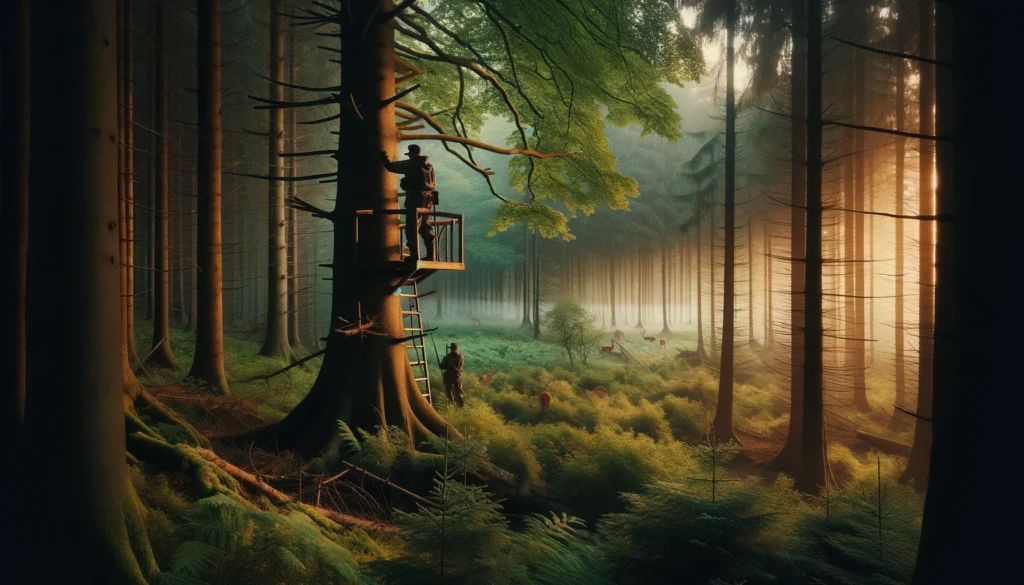Elevating Your Hunt: How to Pick the Perfect Treestand Site

Table of Contents
Introduction
Selecting the ideal treestand site is a crucial element in the strategy of any successful deer hunt. It’s about blending science, intuition, and a deep understanding of the natural environment. This guide will walk you through the essential considerations and tactics to pick a treestand site that maximizes your hunting opportunities.
Understanding Deer Movement
Identify Key Areas
- Food Sources: Look for natural food sources like acorns, berries, or agricultural crops.
- Water Sources: Locate nearby water sources used by deer, especially during early morning or late evening.
- Bedding Areas: Find thick cover where deer feel safe to rest and sleep.
- Travel Corridors: Identify natural pathways deer use to move between these key areas.
Use Technology
Leverage aerial maps and GPS technology to scout potential sites without disturbing the area. Apps and online resources can provide invaluable insights into terrain, cover, and deer movement patterns.
Choosing the Right Tree
Visibility
Pick a tree that offers a broad field of view, allowing you to see deer approaching from various directions. Consider the sun’s path to avoid being blinded during prime hunting hours.
Wind Direction
Select a tree downwind of predicted deer paths to keep your scent away from their sensitive noses. Use prevailing wind direction data to make informed decisions.
Access
Ensure your treestand site is accessible without alerting deer to your presence. Plan a quiet, cover-rich route to and from your stand.
Tree Characteristics
Choose a healthy, sturdy tree that can support your weight and the treestand. It should have enough cover to conceal your silhouette yet allow for clear shooting lanes.
Preparing the Site
Trimming Shooting Lanes
Carefully trim branches to clear shooting lanes, but maintain enough foliage to remain concealed. Be mindful not to overtrim, as this can alert deer to your presence.
Minimizing Disturbance
Set up your stand well before the season starts to minimize disturbance in the area. Allow the local wildlife time to become accustomed to the stand’s presence.
Safety First
Always prioritize safety when choosing a tree and setting up your stand. Use a full-body harness, and ensure your stand is securely attached according to the manufacturer’s instructions.
Seasonal and Weather Considerations
Adjust According to Season
Be prepared to adjust your treestand location as seasons change. Food sources and deer patterns may shift, necessitating a move to stay in prime hunting areas.
Weather Impact
Stay adaptable to weather changes. Wind, rain, and snow can all influence deer behavior and may require a strategic response.
Conclusion
The perfect treestand site is out there waiting for you, blending seamlessly into the natural habits of local deer while offering you the best chance for a successful hunt. By meticulously planning and respecting the environment, you elevate not just your position but your chances of success and the overall hunting experience.
FAQs
How early should I set up my treestand?
Ideally, set up your treestand 2-3 weeks before hunting season begins to minimize disturbance in the area.
Can I use the same treestand site year after year?
Yes, if a site continues to be productive and meets the criteria for a good stand location, it can be used in multiple seasons. However, always be ready to adapt to changing conditions and deer patterns.
How do I ensure my treestand is safe?
Regularly inspect your stand for wear and tear, follow all manufacturer’s installation guidelines, and always wear a safety harness when in the stand.
What do I do if the deer pattern changes mid-season?
Be flexible and ready to move your stand. Continuous scouting and monitoring of deer activity are crucial throughout the season.
Choosing the perfect treestand site requires patience, research, and a deep respect for nature. With the right approach, you can significantly increase your chances of a memorable and successful hunt.







